David Cook
Well-known member
Circa 1996, a Japanese company called ADTX produced a SCSI to IDE adapter for 2.5 inch IDE hard drives to work in SCSI Macintosh PowerBook computers. Recently, I purchased one on eBay and got another inside a parts machine PowerBook 165c. Both adapters are labeled part number A360025. I assume the other number (9647 and 9651) on the label is the serial number.
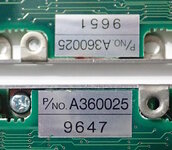
Both ROMs are labeled 10TA32 96/9/07

Curiously, the adapter found in the PowerBook 165c (1993) had an Apple branded IBM 1GB hard drive from 1996 with an ADTX sticker labeled AX-HDD-1298. The date suggests the drive was removed by the user from another machine to install in the PowerBook 165c. Or, the fact that this drive has both an Apple label and ADTX label suggests that maybe ADTX was buying Apple drives and reselling the combination as a replacement for failing drives in older PowerBooks?
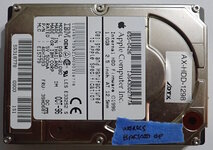
There is a cool bridge connector that stacks the drive to the ADTX board. If you buy an ADTX board second-hand, make sure you get this bridge connector with it.
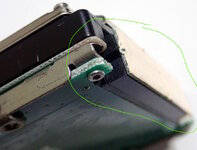
Speaking of which, below is my connector stack to adapt a full-size desktop SCSI machine to a compact flash. Left to right: aberco (eBay) "2.5" to 3.5" SCSI 50 pin laptop hard disk drive adapter Apple PowerBook", ADTX SCSI IDE adapter, ADTX connector, SinLoon "CF to IDE Adapter CF Memory Card to 2.5-inch 44Pin Male IDE Laptop SSD HDD Adapter Card (CF/IDE M)" https://amzn.to/495vLiU, SanDisk Ultra CompactFlash 2GB 15MB/s.

And here is my connector stack to adapt a full-size desktop SCSI machine to an mSata. Same as above except the two items on the far right: Chenyang "mSATA Mini PCI-E SATA SSD to 2.5 inch IDE 44pin Hard Disk Case Enclosure Box White for Notebook Laptop" https://amzn.to/47kHgS7, and DogFish "SSD SATA mSATA 128GB Dogfish Internal Solid State Drive High Performance Hard Drive for Desktop Laptop SATAIII 6Gb/s 128GB" https://amzn.to/46FC4bb

I tried some other CompactFlash adapters and other mSata adapters but they did not work. The ADTX is very fussy.
Additionally, I tried numerous other CompactFlash media without success. All the cards below work in a PC (the IBM microDrive may be dead), and those marked 'IDE' also worked in a Macintosh with a Sonnet Macintosh PCI IDE card.

To be clear. I could not get any of these CompactFlash cards working with the ADTX adapter.
Performance Testing
I expected that mSata media connected to a 68K SCSI Mac through that ADTX adapter would perform significantly better than a miniSD card through a SCSI emulator. I was wrong.
My test setup is a Macintosh IIci without a cache card or NuBus cards (so built-in video), 20MB ram, 128KB disk cache, and System 7.1.
Below is the performance of an external SCSI hard drive (branded APS) IBM 2GB. Notice peak throughput of 1700 KB/s but with a relatively slower Butteryfly and Outer to Inner seek time because the hard drive head has to physically move to reach a track. This means the drive can really pump out data when in the correct position, but there is a little delay (seek time) to find the right track. Performance would suffer on a fragmented volume, random access, or copying a bunch of little files.
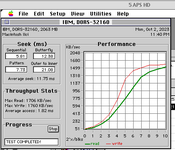
Now here is MacSD (stock, not overclocked). This is miniSD media with emulated SCSI hardware. The peak throughput is slower than a physcial hard drive, but the seek times are multiple times faster because there aren't drive heads to move.
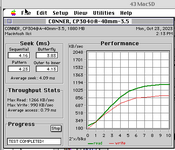
Let's check out the IDE IBM hard drive connected to the ADTX, just as I received it from the PowerBook 165c. Note the scale (Y-axis) is half the other charts. This setup performs worse is all regards compared to the MacSD.
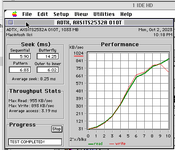
But what if we switch to mSata media? Awful throughput.

A clue to the poor performance is in the red text on the above image. I tried other SCSI drivers and it doubled the throughput performance. (The Y-Axis scale is now back to 2048). Something about FWB Hard Disk Toolkit (version 2.0.6) did not jive with the ADTX. However, other than write throughput, MacSD is still better than ADTX mSata.
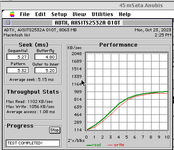
ADTX with 2GB SanDisk Compact Flash is about the same, except it has glitchy write performance. I tried this test multiple times and got identical results. It's something to do with the Compact Flash erase/write cycles I assume.
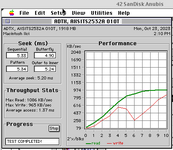
The point of all of this is that seeking out a relatively rare ADTX adapter and finding compatible solid-state media and adapters does not produce a performance boost over modern SCSI emulators. Bummer.
Maybe Not Intended?
There are eight dip switches on the ADTX adapter. Perhaps I did not have them set correctly for maximum performance? My initial reverse engineering shows that the dip switches connect to ground on one side and are pulled up through 10K resistors on the other side. All the switches connect to the LSI KL5C80A16CF microcontroller. Okay, so these are software settings.
The leftmost three switches (1, 2, 3) also connect to the external SCSI ID output pins. The only other connected external pin outputs to an external SCSI activity LED.
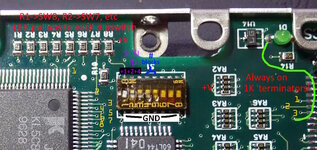
There are other versions of the ADTX adapter board. Apparently switches 4 & 5 affect termination on those boards. However, on my version, termination is fixed with 1K resistors. That's weird. The termination resistors should be stronger. I suspect this board was intentionally designed for slower performance in exchange for lower power usage, which would be important on a laptop computer.
On my board, switches 4 & 5 change the expressed number of blocks on the media, at least as far as Hard Disk Toolkit sees them:
4 OFF 4 ON
5 OFF 1055376 1583568
5 ON 2116800 16514064
Playing with these switches and the unknown switches (6, 7, 8) did not seem to affect compatability or performance.
So, in summary, just buy a modern SCSI emulator instead.
- David

Both ROMs are labeled 10TA32 96/9/07

Curiously, the adapter found in the PowerBook 165c (1993) had an Apple branded IBM 1GB hard drive from 1996 with an ADTX sticker labeled AX-HDD-1298. The date suggests the drive was removed by the user from another machine to install in the PowerBook 165c. Or, the fact that this drive has both an Apple label and ADTX label suggests that maybe ADTX was buying Apple drives and reselling the combination as a replacement for failing drives in older PowerBooks?

There is a cool bridge connector that stacks the drive to the ADTX board. If you buy an ADTX board second-hand, make sure you get this bridge connector with it.

Speaking of which, below is my connector stack to adapt a full-size desktop SCSI machine to a compact flash. Left to right: aberco (eBay) "2.5" to 3.5" SCSI 50 pin laptop hard disk drive adapter Apple PowerBook", ADTX SCSI IDE adapter, ADTX connector, SinLoon "CF to IDE Adapter CF Memory Card to 2.5-inch 44Pin Male IDE Laptop SSD HDD Adapter Card (CF/IDE M)" https://amzn.to/495vLiU, SanDisk Ultra CompactFlash 2GB 15MB/s.

And here is my connector stack to adapt a full-size desktop SCSI machine to an mSata. Same as above except the two items on the far right: Chenyang "mSATA Mini PCI-E SATA SSD to 2.5 inch IDE 44pin Hard Disk Case Enclosure Box White for Notebook Laptop" https://amzn.to/47kHgS7, and DogFish "SSD SATA mSATA 128GB Dogfish Internal Solid State Drive High Performance Hard Drive for Desktop Laptop SATAIII 6Gb/s 128GB" https://amzn.to/46FC4bb

I tried some other CompactFlash adapters and other mSata adapters but they did not work. The ADTX is very fussy.
Additionally, I tried numerous other CompactFlash media without success. All the cards below work in a PC (the IBM microDrive may be dead), and those marked 'IDE' also worked in a Macintosh with a Sonnet Macintosh PCI IDE card.

To be clear. I could not get any of these CompactFlash cards working with the ADTX adapter.
Performance Testing
I expected that mSata media connected to a 68K SCSI Mac through that ADTX adapter would perform significantly better than a miniSD card through a SCSI emulator. I was wrong.
My test setup is a Macintosh IIci without a cache card or NuBus cards (so built-in video), 20MB ram, 128KB disk cache, and System 7.1.
Below is the performance of an external SCSI hard drive (branded APS) IBM 2GB. Notice peak throughput of 1700 KB/s but with a relatively slower Butteryfly and Outer to Inner seek time because the hard drive head has to physically move to reach a track. This means the drive can really pump out data when in the correct position, but there is a little delay (seek time) to find the right track. Performance would suffer on a fragmented volume, random access, or copying a bunch of little files.

Now here is MacSD (stock, not overclocked). This is miniSD media with emulated SCSI hardware. The peak throughput is slower than a physcial hard drive, but the seek times are multiple times faster because there aren't drive heads to move.

Let's check out the IDE IBM hard drive connected to the ADTX, just as I received it from the PowerBook 165c. Note the scale (Y-axis) is half the other charts. This setup performs worse is all regards compared to the MacSD.

But what if we switch to mSata media? Awful throughput.

A clue to the poor performance is in the red text on the above image. I tried other SCSI drivers and it doubled the throughput performance. (The Y-Axis scale is now back to 2048). Something about FWB Hard Disk Toolkit (version 2.0.6) did not jive with the ADTX. However, other than write throughput, MacSD is still better than ADTX mSata.

ADTX with 2GB SanDisk Compact Flash is about the same, except it has glitchy write performance. I tried this test multiple times and got identical results. It's something to do with the Compact Flash erase/write cycles I assume.

The point of all of this is that seeking out a relatively rare ADTX adapter and finding compatible solid-state media and adapters does not produce a performance boost over modern SCSI emulators. Bummer.
Maybe Not Intended?
There are eight dip switches on the ADTX adapter. Perhaps I did not have them set correctly for maximum performance? My initial reverse engineering shows that the dip switches connect to ground on one side and are pulled up through 10K resistors on the other side. All the switches connect to the LSI KL5C80A16CF microcontroller. Okay, so these are software settings.
The leftmost three switches (1, 2, 3) also connect to the external SCSI ID output pins. The only other connected external pin outputs to an external SCSI activity LED.

There are other versions of the ADTX adapter board. Apparently switches 4 & 5 affect termination on those boards. However, on my version, termination is fixed with 1K resistors. That's weird. The termination resistors should be stronger. I suspect this board was intentionally designed for slower performance in exchange for lower power usage, which would be important on a laptop computer.
On my board, switches 4 & 5 change the expressed number of blocks on the media, at least as far as Hard Disk Toolkit sees them:
4 OFF 4 ON
5 OFF 1055376 1583568
5 ON 2116800 16514064
Playing with these switches and the unknown switches (6, 7, 8) did not seem to affect compatability or performance.
So, in summary, just buy a modern SCSI emulator instead.
- David

